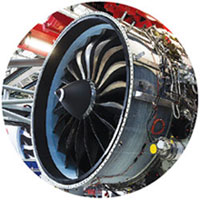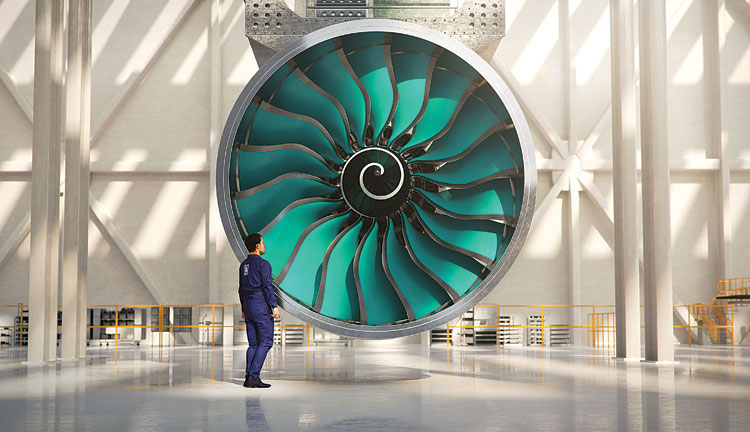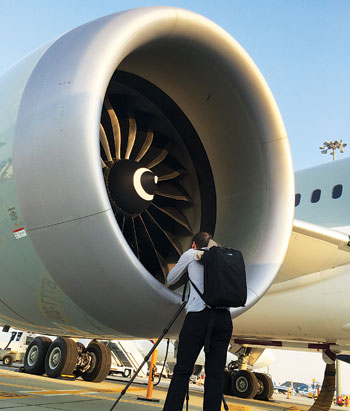Greener Skies: Engine Manufacturers’ Initiatives
While environmental activists insist that the only way to reduce aviation emissions is to take some planes out of the sky, engine manufacturers are making concerted efforts to reduce fuel burn

Since the first turbojet powered aircraft, the Heinkel He 178 V1, flew on August 27, 1939, in Rostock, Germany, the jet engine has been acknowledged as one of the most complex and highly stressed machines ever developed. Commercial jet engines must be lightweight, efficient and economical to operate, yet safe and reliable. And now, there is unprecedented pressure on engine manufacturers from environmentalists and governments to reduce the adverse impact of their products on climate change. Aircraft and engines are indeed getting more fuel-efficient, but airline traffic continues to gallop ahead at an ever increasing rate.
Aviation currently accounts for just two to three per cent of Greenhouse Gas (GHG) emissions that lead to climate change. However, the scale of airliner deliveries in the coming decades is likely to dwarf the projected efficiency gains, making aviation’s share of emissions rise to an estimated 10 and 25 per cent by 2050. Unfortunately, the industry still lacks viable ‘clean’ energy alternatives. Bio-fuels have great potential, but costs are high and production is pitifully meagre. Electrical propulsion is considered a fairly non-polluting option. However, large aircraft running on electricity are unlikely to be a reality for several decades to come.
Will the large airliner of the future be powered by some revolutionary propulsion system or can jet engine technology itself see major innovations that drastically improve fuel efficiency and lead to greener skies?
STEP CHANGE
The Pratt & Whitney PW1100G high-bypass geared turbofan engine that entered commercial service in January 2016, on the Airbus A320neo aircraft, provides a welcome step change in fuel efficiency. This engine uses a large fan (more than two metres in diametre) and a gearbox to make the fan rotate more slowly than the turbine that drives it. Pratt & Whitney believes that this innovative engine, on which it spent more than 20 years and $10 billion to develop, has the potential to transform commercial aviation. As promised, it is delivering game-changing economic and environmental performance including a 16 per cent reduction in fuel consumption, a 75 per cent reduction in noise footprint and a 50 per cent reduction in Nitrogen Oxide (N2O) emissions.
Perhaps inevitably for a complex new engine, the engine has experienced a few glitches that have necessitated some modification. This has affected the aircraft induction programmes as well as the flight schedules of some operators such as IndiGo Airlines and GoAir. However, thanks to the constant efforts of the manufacturer to address these issues, the worst seems to be over, and the innovative engine seems set for a bright future.
The CFM International LEAP-1 engine that started revenue service in May 2017 powering a Boeing 737 MAX aircraft, also delivers many of the benefits of the PW1000 series, but with conventional turbofan architecture and without the additional weight and complexity of a gearbox. It uses lightweight composite materials such as carbon fibre fan blades to achieve comparable fuel efficiency gains.
A BIGGER AND GRENER FUTURE
More recently, Boeing seems to have put its recent 737 MAX troubles behind it. The futuristic Boeing 777X wide-body aircraft powered by the new General Electric GE9X high-bypass turbofan engine got airborne for the first time on January 25 this year and the flight was flawless. Typically, the Boeing 777-9 will carry 426 passengers over a range of 7,285 nautical miles. It is the Boeing company’s biggest jet airliner and its 71.8-metre wingspan makes it the largest twinjet in the world. Naturally, its engines are also massive with 16 fan blades of 340-cm diameter crammed into the engine capsule. Rated at 1,05,000 lbf (470 kN) of thrust, the GE9X is built with advanced materials such as Ceramic Matrix Composites (CMC) and Carbon Fibre Composites (CFC). Fourth-generation CFCs make the fan blades lighter, thinner, stronger and more efficient. A composite fan case further reduces weight. With its impressive 10:1 bypass ratio and 61:1 overall pressure ratio, the engine is expected to enhance fuel efficiency by ten per cent over its predecessor, the General Electric GE90. A large aircraft such as the Boeing 777-9 is also far more economical to operate than two or three smaller aircraft totalling to equivalent passenger capacity.

The CFM International LEAP-1 engine that started revenue service in May 2017 powering a Boeing 737 MAX aircraft with conventional turbofan architecture and without the additional weight and complexity of a gearbox. It uses lightweight composite materials such as carbon fibre fan blades to achieve comparable fuel efficiency gains.
Rolls-Royce claims that across the Atlantic, its cutting-edge Ultrafan technology will deliver a 25 per cent improvement in fuel burn compared to the first generation of its Trent engines and will “re-define the world of jet engines”. The Ultrafan, expected to be ready for ground testing later this year, will have a very large fan, perhaps as much as 350 cm in diameter. This huge fan will be possible thanks to the addition of a gearbox – a first for such a large engine. Rolls-Royce has developed special robots to make the fan blades from carbon fibre. The use of CMCs and super nickel alloys besides CFCs for the fan casing and blades could result in a 20 per cent weight saving compared with previous materials. The Ultrafan is a scalable design that can improve fuel efficiency on narrow or wide-body airliners entering service from the mid-2020s.
HYBRID AIRCRAFT
However, Rolls-Royce is not putting all its eggs in the jet basket; it is also collaborating with Siemens and Airbus in the development of a hybrid aircraft on which one of the four engines will be powered solely by electrical energy. If the hybrid plane, known as E-Fan, flies in 2021 as planned, the technology could be put to commercial use in the early 2030s to power short distance flights with a limited number of passengers. It could go a long way in meeting with the goals of the European Union of cutting CO2 emissions by 75 per cent by 2050, while reducing emissions of Nitrous Oxide (N2O) by 90 per cent and generation of noise by 65 per cent.

Even though scores of small all-electric aircraft are currently under development, large long-haul aircraft propelled fully by electrical power may be many decades away because their power requirement is just too great. Battery weight currently accounts for as much as a third of the total aircraft weight and concerns regarding the potential fire hazard from batteries are yet to be adequately addressed. Hybrid aircraft, therefore, seem a far more viable proposition.
SIMPLY SABRE
In a completely different class is the Synergistic Air-Breathing Rocket Engine (SABRE) fitted on the proposed Skylon space plane. It is being developed by Reaction Engines, a company in the United Kingdom and promises a step change in propulsion. The SABRE will basically consist of three sections – a pre-cooler in front, a core combustion section with a smart thermo-dynamic cycle in the middle and a rocket arrangement at the rear. The SABRE will be capable of flying at Mach 5.4 in the air-breathing mode and up to Mach 25 in the rocket mode. At low speeds and low altitude, the SABRE would behave like a conventional jet engine, using atmospheric air for combustion and generation of power. As the aircraft accelerates to Mach 5, the air entering the engine would normally reach temperatures high enough to melt it like butter. Hence the compact pre-cooler heat-exchanger would be a key assembly, capable of taking an incoming airstream of over 1,000 degrees centigrade and cooling it to 150 degrees centigrade in less than 1/20th of a second. At high speeds and high altitude, the SABRE could be switched to the rocket mode for possible space flight. It is expected to be flight tested as early as in 2021.

PLANFORM PLANNING
As for the venerable jet engine, many analysts believe that it has already reached somewhere close to its technological limits. Fan and compressor blade design will continue to make minor advances and the relatively new geared turbofans may see significant evolution. But jet engines cannot get much more efficient without major innovation or radical redesign. Or even a switch to hydrogen as fuel.
Sooner or later, the aviation industry may be forced to make a transition from the current ubiquitous tube and wing design, with engines hanging below the wings, to a ‘blended wing’ design – an aircraft having no clear dividing line between the wings and the fuselage. According to NASA, the Blended Wing Body (BWB), a plane with a radical hybrid wing shaped body, will burn 27 per cent less fuel than the most economical engines currently in use. Commercial designs could be available by 2035. However, there are safety issues, especially in the emergency evacuation of passengers onboard a BWB. Also, passengers may be reluctant to sit in a windowless environment while those seated far from the centreline would experience considerable discomfort while the aircraft is executing turns.
While environmental activists insist that the only way to reduce aviation emissions is to take some planes out of the sky, engine manufacturers and airline operators are making concerted efforts to reduce fuel burn. Apart from more fuel-efficient engines, the measures include use of lighter materials, improved aerodynamics and more efficient operating procedures. Every effort towards the cherished goal of greener skies counts. After all, each tonne of fuel saved means a saving of three tonne of CO2 emissions.





